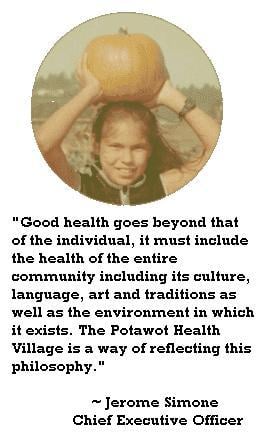

United Indian Health Services' Potawot Health Village is a 42,000-square-foot health facility located on a 40-acre site next to Mad River Hospital in Arcata, Humboldt County, California. It serves 9 tribes and over 13,000 Native Americans in Northern California. Traditionally, health services for Native Americans have been quite under par. Potawot is the result of Native peoples' taking the health of their communities into their own hands rather than relying on the government or other private organizations to help. They offer medical, dental, mental health, and nutrition services to the Native American community. Conventional health services may hinder rather than help the sick, in terms of isolation, dependence, and separation from the natural environment. Potawot encompasses traditional means towards healing by integrating processes that are 10,000 years old. This facility is also designed to be very sustainable, for example:
- The grounds around the main building are marked with trails and an organic farm.
- The organic farm produces for an on-site farmer's market.
- Paths are made from a pine pitch and shale alternative pavement.
- The land is undergoing restoration, including seed-collecting, natural grasses reintroduction.
- The floors are made of reclaimed 2x4 ends.
- The roofs were designed to facilitate solar panel installation. Funding has recently been procured to install panels.
- Integrated stormwater management creates a sinuous series of stormwater treatment wetlands, adding to the natural habitat and groundwater recharge.
Potawot covers nine tribes and more than 13,000 American Indians, consisting mainly of Yurok, Weeot and Tolowa Tribal members. Potawot hosts UIHS's nationally recognized tobacco awareness and diabetes prevention programs which are featured at the new Health Village.[3] Because diabetes has become such a severe problem in the community, and throughout the world, Potawot and the United Indian Health Services (UIHS) have begun to take steps to address the problem (Fig. 2). The Potawot diabetes outreach program allows its participants to join groups that go on walks (Fig. 3 through 5) Monday through Wednesday during clinic hours.[4]
Site[edit | edit source]
Related Links[edit | edit source]
- United Indian Health Services Official Webpage
- Potawot Health Village Project Description and Site Plan
- Some photos
- Stormwater Management System
References[edit | edit source]
- ↑ 1.0 1.1 http://web.archive.org/web/20091001063435/http://www.uihs.org:80/kuwahdahwilth.html Potawot Images provided by UHIS Accessed: 10/26/08
- ↑ 2.0 2.1 Pictures Edited By User: Yuvizela Martinez on 10/27/08
- ↑ http://web.archive.org/web/20100919205233/http://pages.prodigy.net:80/richardspini/_wsn/page5.html Potawot Info Services Last Accessed: 10/28/08
- ↑ Interview of Barbara Piefer from Potawot 10/28/08 (707) 825-4180 (Interviewed by Juliene Sinclairand Yuvizela Martinez)